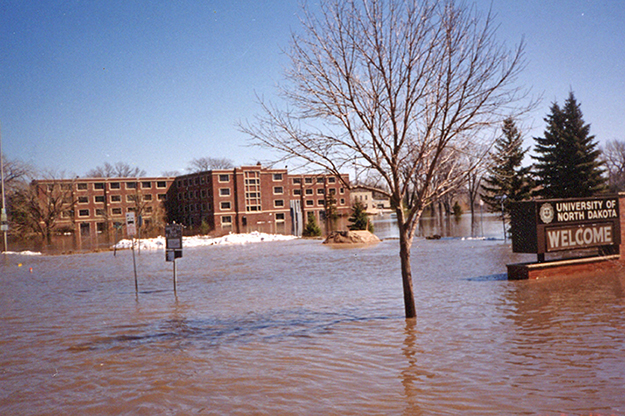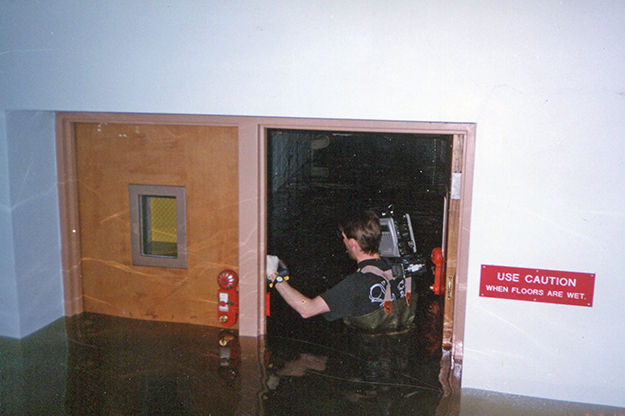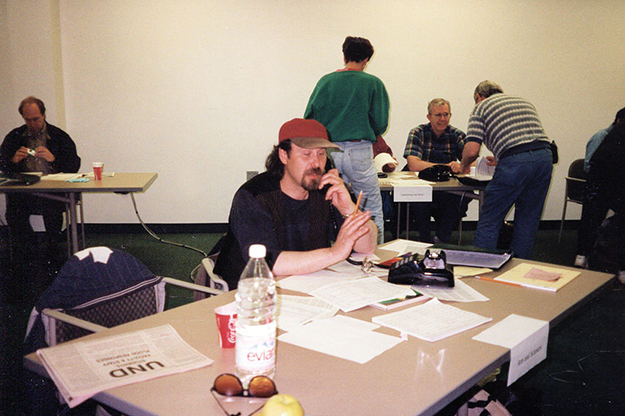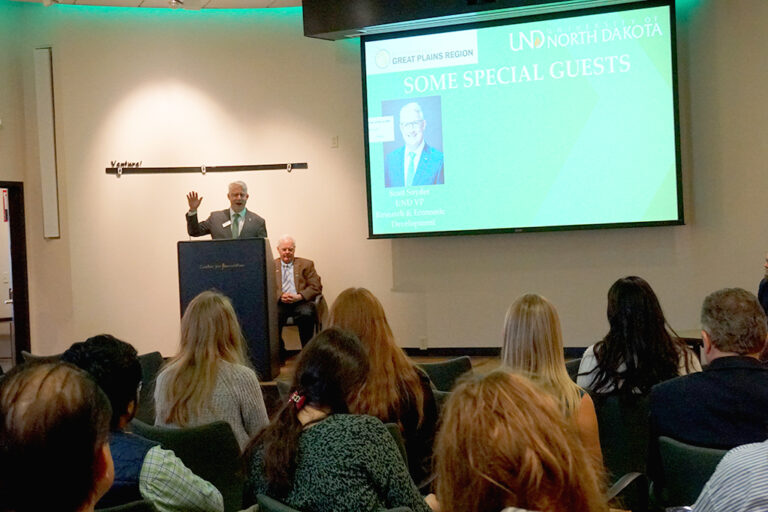Event of the century
UND looks back at historic flood 20 years after Red River and English Coulee conspire to inundate campus, end spring semester abruptly and shoo students, staff and faculty toward higher ground

The battle had been fought many times before, and mostly won. But the flood of 1997 would be different. Heroic efforts were thrown at it; in the end, these were no match for the sheer volume of water unleashed from one of the harshest winter seasons the Red River Valley had seen.
By early January, it was apparent that flooding was likely to reach major levels. “Sandbag Central” in Grand Forks’ Public Works Facility opened on March 15. The cities began laying extra clay on top of their dikes to contend with a predicted 49-foot crest. Sandbag dikes were started in areas where heavy equipment could not operate. UND prepared by stockpiling sandbags, pumps and other supplies, and organizing response crews.
Blizzard Hannah
Students and townspeople were already recognizing that this was going to be a serious fight when “Blizzard Hannah” struck. In that April 5-7 event, rain turned to ice and was followed by wind, heavy snow and plunging temperatures. About two-thirds of the Red River Valley would spend the weekend without electricity, and some rural areas would not regain power for two weeks. The UND campus was likewise dark and cold, with residence hall students served only a “cold brunch” of cereal and peanut butter sandwiches.
Digging out of this new snow and undoing storm damage were not the only complications of Blizzard Hannah. The frigid weather meant that sandbags stored in unheated areas had frozen, making them useless for building dikes. Those sandbags had to be taken to UND’s Recycling Center to thaw out — a process that could take a day and a half, when time was running short.
By now, thousands of community residents, students, faculty and staff had joined in the effort to make and place sandbags, and the National Guard had been called to duty. UND’s Plant Services organized special teams to make speedy responses to critical situations.
River rising
On Tuesday, April 15, the Red rose above 46 feet and the National Weather Service upped its crest prediction to 50 feet. The afternoon was chilly as small armies of volunteers started building sandbag dikes on campus. Wilkerson and Smith Halls were the principal concerns; dikes were also thrown up by Gustafson and Chandler Halls, (old) Engelstad Arena, the Delta Upsilon and Gamma Phi Beta houses, and transformers near Wilkerson and the Chester Fritz Auditorium.
Wednesday, April 16, saw a new level of intensity with the flood fight. UND officials canceled classes for that afternoon and Thursday to free students, faculty and staff for the flood fight. Meanwhile, city parks and the open fields of UND’s north campus (Bronson Property) were being mined for more clay. Grand Forks Mayor Pat Owens and city officials recommended that residents be prepared to leave.

Over, under, around and through
That recommendation became reality on Thursday. As dikes began leaking, the order was given to evacuate the Lincoln Drive area at 4 a.m. The National Weather Service revised its crest prediction up to 52 feet. By that afternoon, the river had overtopped the dikes in Lincoln Drive, and the Point area of East Grand Forks was flooding. Mayor Owens said the entire city might need to be evacuated.
Water was coming from every direction: over, around and through dikes, down streets, over land and from the English Coulee, and through the sewers.
That evening, the Central Park area went under, and water started moving into downtown. The Emergency Operations Center, located in the basement of the Police building, was quickly relocated to UND’s Plant Services Building. From that point on, the west campus became the headquarters for local, state and national responses to the flood.

Too much — or no water
On Friday, the flood had claimed the Lincoln Drive, Riverside and Central Park neighborhoods of Grand Forks, and the Point on the East side. UND classes were canceled again, and a desperate effort was made to save the Smith Hall sandbag dike. Residence hall parking lots were flooding, and students started to evacuate. Then, President Kendall Baker heard that the city was losing its water service. That meant no drinking water, no sewer service, and no water for UND’s steam heating system. There was no choice but to close the University and cancel the rest of the semester. The National Weather Service raised its crest prediction to 53 feet and then to 54 feet.
By noon Saturday (April 19), half of Grand Forks and nearly all of East Grand Forks was under water. The Smith Hall dike effort was abandoned, and preparations began to move UND’s mainframe computer to Fargo. Sewer backup began to fill the lower level of the School of Medicine, while volunteers struggled to keep water out of the Energy and Environmental Research Center. And then a spectacular fire broke out in flooded downtown Grand Forks and grabbed national attention.
Sunday (April 20) saw electricity and gas service shut off to much of the community. Three-fourths of Grand Forks and virtually all East Grand Forks residents had evacuated. A core group of UND leaders set up twice-daily meetings to evaluate the campus situation and plan action. Streets in the campus neighborhood were filled with water and rising. Volunteers quickly turned out to move the University’s most valuable holdings to higher levels, particularly in the Chester Fritz Library. At the same time, sewer backup was filling the lower level of Wilkerson and numerous other campus buildings.

Crisis to recovery
The Red River had not yet crested, but UND officials were looking ahead to what needed to be done when the event was over. Some important steps had been taken before the flood peaked. Many buildings had been powered down, preventing more serious damage to some electrical systems. Still, there was going to be an enormous amount of damage to repair.
On Monday, efforts were redoubled to shore up a sandbag dike protecting a crucial transformer near the Hughes Fine Arts Center. The effort to keep water out of the EERC had to be called off. Meanwhile, UND officials started planning a phone-based “virtual university,” and President Baker announced that the summer session would start as planned, on May 12.
At midnight, the Red finally crested at 54.33 feet. The community continued to be the focus of national news as President Bill Clinton flew in Tuesday to view the disaster and visit with state and local officials, as well as displaced residents.
The retreat of the floodwater — slow, but noticeable — brought a swift change in mood. The heightened urgency of fighting a disaster, from being “in the moment,” was replaced by the need to tackle an almost overwhelming “to do” list.
There was carpeting and drywall to tear out, and walls and surfaces to scrub and disinfect. Combatting mold was one of the more serious issues of the recovery. There were items of every level, from coffeepots and chairs to electron microscopes, to inspect and decide whether to save or throw.
It was grimy, tedious, frustrating, exhausting work. And for so many UND people, that was compounded by the often heartbreaking situations presented by their own flood-damaged homes.

Refuge and reputation
On Friday, May 2, water service was restored to much of Grand Forks. President Baker announced that the University would provide temporary summer housing in its residence halls for displaced faculty, staff and community residents. In the summer, part of UND’s north campus was set up with one of three FEMA trailer courts in Greater Grand Forks.
The impact of the flood was huge: 72 buildings affected, extensive damage to steam lines, electrical and mechanical facilities, sanitary and storm sewer systems, not to mention roads, sidewalks, parking lots, lawns, athletic facilities, and more. Total costs for flood fighting, repairs and lost revenue (but not including lost tuition income) were estimated at about $75 million.
There was also an intangible to repair: the reputation of the community and the University. A survey of other institutions that had experienced disasters showed that a big enrollment drop was likely. Getting the word out — that the University and the community were on the rebound — became a top priority. Thousands of volunteers helped make that happen.
It took work, but in four years UND’s enrollment passed its pre-flood mark. The University and the Greater Grand Forks community drew frequent notice for the success of their rebuilding efforts.
Today, Grand Forks and East Grand Forks are protected with a vastly improved flood control system. New generations of UND students have little awareness of the momentous event of 1997. But for those who were here, the fight and its aftermath — and particularly the strength of the people — remain vivid in their memories and outlook.
Kendall Baker accepted the presidency of Ohio Northern University in 1999, and served there until retiring in 2012. He observed, “There was one powerful lesson I learned from the flood that I remembered throughout the remainder of my years as a president. That was, quite simply, the extraordinary capability and resilience of people. We were fortunate during those difficult days at UND to have faculty, staff and students who were totally committed to doing everything they possibly could to protect the community and University. It made no difference whether what they were asked to do was connected to their normal work at the U or whether it drew upon their other talents and abilities. They dedicated themselves to the task and the task got done. Extraordinary colleagues and friends ‘made things happen’ in the days before the flood and in the weeks and months after. When I subsequently had to address the difficulties following the 911 attack and then an ice storm that closed Ohio Northern University for several days, I knew to find special leaders at all levels and ask them to help us work through the crises.”
Check out these additional interesting resources about UND’s connections to the historic Flood of 1997:
UND Digital Press:
The Digital Press @ the University of North Dakota is proud to announce the publication of Haunted by Waters, an anthology written, collected, and edited by Dr. David Haeselin and students from the writing, editing, and publishing certificate program in UND’s English department. Including new additions from various contributors and archival documents, this anthology explores the Greater Grand Forks area twenty years after the devastating Red River of the North flood of 1997.
UND Department of Special Collections:
The Flood Calls project is a collection of Grand Forks 911 calls from the day of the Flood of 1997. How many? 2,014. The archive covers the period from 4:30 a.m., April 18 to 1:15 a.m., on April 19, 1997. The original recordings were supplied to UND’s Elwyn B. Robinson Department of Special Collections in the Chester Fritz Library by the Grand Forks Public Safety Answering Point when it moved to a new, all-digital recording system in 2007.


